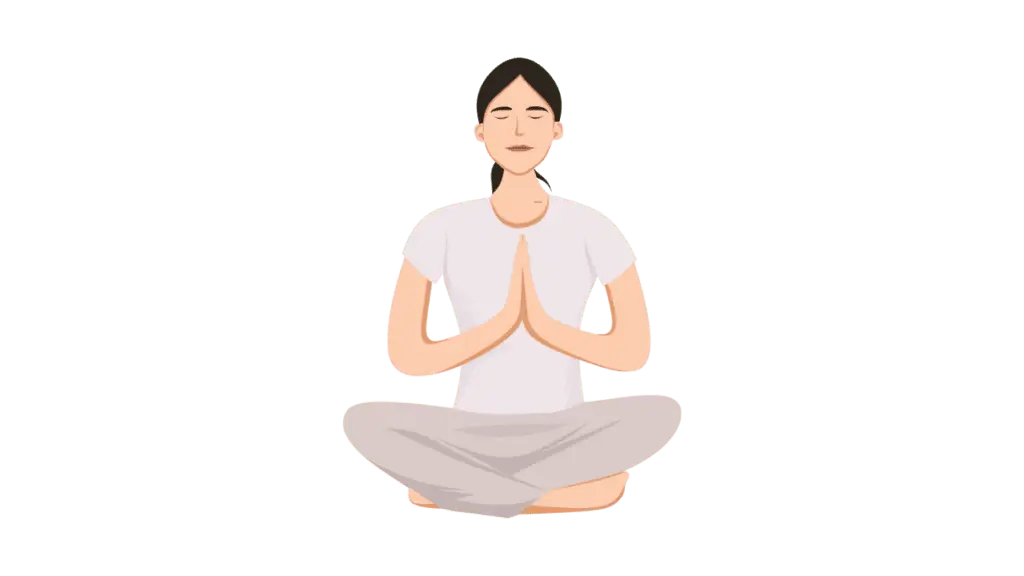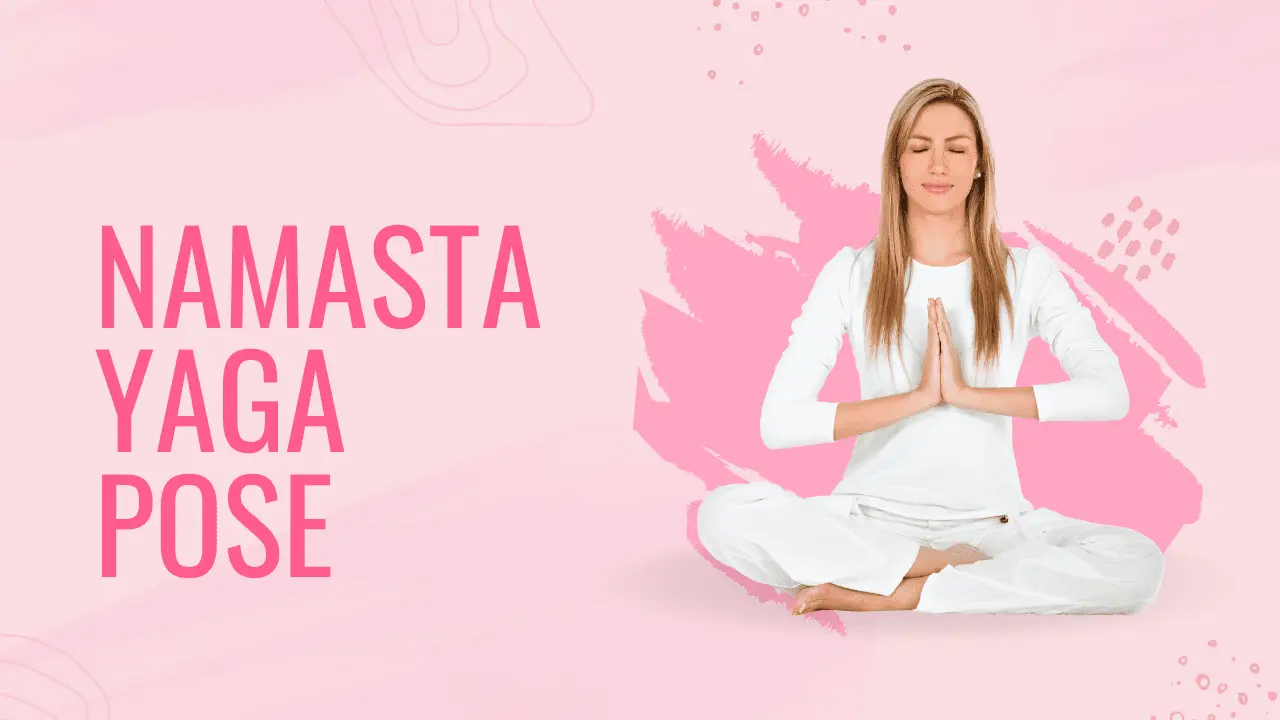Namaste! Ever wondered why every yoga class starts and ends with this serene gesture? The Namaste Yoga Pose, often accompanied by a warm greeting, holds deeper significance than just a respectful hello. In this post, we’ll dive into the Namaste Pose’s history, benefits, and how to do it correctly. Whether you’re a yoga newbie or a seasoned practitioner, this guide will enrich your understanding and practice of this beautiful pose. So, let’s embark on this journey of discovery together!
What is the Namaste Yoga Pose?
The Namaste Pose is a simple yet profound gesture that involves bringing your palms together at the heart center, bowing your head slightly, and closing your eyes. It’s not just a physical posture but a symbolic act of greeting, gratitude, and respect. This pose is often seen in various yoga practices and spiritual traditions, symbolizing the unity of mind and heart, and acknowledging the inner light in oneself and others.

Cultural Significance of Namaste
Namaste, derived from Sanskrit, means “I bow to you.” It’s widely used in India and Nepal as a form of greeting. In yoga, it signifies the belief that there is a divine spark within each of us. The gesture represents the acknowledgment of this divinity, promoting a sense of unity and respect. This cultural practice transcends mere words, embodying a deep sense of humility and interconnectedness that can enrich our daily interactions and relationships.
How to Perform Namaste Pose
Performing the Namaste Pose is simple. Here’s a step-by-step guide:
- Stand or sit comfortably with your spine straight, ensuring your body is relaxed but alert.
- Bring your palms together in front of your chest, fingers pointing upwards, and press them gently but firmly.
- Bow your head slightly and close your eyes, feeling a sense of calm wash over you.
- Take a deep breath and feel the connection within, focusing on the present moment and the unity of mind and body.
- Hold the pose for a few moments to fully experience the sense of peace and mindfulness before gently releasing.
Curious about more yoga poses? Check out our detailed guide on “Egg Yoga Pose” for another enriching addition to your practice!
Emotional and Mental Benefits
Beyond the physical, the Namaste Pose touches the heart and mind:
- Cultivates gratitude: Encourages a mindset of thankfulness, helping you appreciate the little things in life.
- Builds connections: Fosters a sense of community and respect, making social interactions more meaningful.
- Promotes mindfulness: Centers your thoughts and enhances awareness, helping you stay present and engaged in your daily activities.
Physical Benefits of Namaste Pose
The Namaste Pose might seem simple, but it offers several physical benefits:
- Improves posture: Encourages a straight spine, which is essential for overall health.
- Relieves stress: Promotes a sense of calm and peace, reducing tension in the shoulders and neck.
- Enhances focus: Helps center your mind, making it easier to concentrate on tasks and maintain clarity throughout the day.
Namaste in Different Cultures
While Namaste is rooted in Indian culture, similar gestures exist worldwide:
- Thailand: The “wai” is a similar gesture of greeting, symbolizing respect and humility.
- Japan: Bowing serves a comparable purpose, reflecting deep cultural values of honor and reverence.
- China: The “fist and palm salute” is a traditional gesture of respect and greeting.
- Philippines: The “mano” involves taking the hand of an elder and pressing it to the forehead, showing deep respect.
- Tibet: The “palms together” gesture is used in greetings, prayer, and meditation, symbolizing unity and peace.
Curious about more yoga poses? Check out our detailed guide on “Rebound Pose Yoga” for another enriching addition to your practice!
Namaste in Yoga Practice
In yoga classes, the Namaste Pose is commonly used at the beginning and end of sessions. It serves as a reminder to approach the practice with respect and mindfulness, setting a peaceful tone for the session. This ritual helps create a sacred space where practitioners can connect with themselves and others, fostering a collective sense of purpose and harmony.
Variations of the Namaste Pose
While the basic Namaste Pose is universal, variations exist:
- Anjali Mudra: Palms together at the heart, used in meditation to deepen the sense of inner peace and balance.
- Pranamasana: Similar to Namaste, but often performed standing in Tadasana (Mountain Pose), emphasizing grounding and stability.
- Lotus Mudra: Palms together with fingers spread open like a lotus flower, symbolizing purity and enlightenment.
- Jñana Mudra: Palms together at the heart with the thumb and index finger touching, often used in meditation to enhance concentration and wisdom.
Namaste and Yoga Philosophy
In yoga philosophy, Namaste embodies key principles like unity, respect, and mindfulness. It’s a physical manifestation of the core values of yoga, reminding us of our interconnectedness and the importance of approaching life with a heart full of compassion and gratitude.
Incorporating Namaste in Daily Life
You don’t have to be on a yoga mat to practice Namaste. Try incorporating it into your daily routine:
- Morning ritual: Start your day with a moment of gratitude, setting a positive tone for the hours ahead.
- Before meals: Acknowledge the nourishment you’re about to receive, cultivating a sense of appreciation and mindfulness.
- At bedtime: Reflect on your day with appreciation, reinforcing the positive moments and learning from the challenges.
The Spiritual Aspect
The spiritual significance of Namaste goes beyond the physical gesture. It’s about recognizing the divine in everyone and everything around you, fostering a deeper sense of connection and peace. This practice can transform your perspective, encouraging a more compassionate and empathetic approach to life.
Teaching Kids the Namaste Pose
Teaching children the Namaste Pose can instill values of respect and mindfulness early on. It’s simple, fun, and a great way to introduce them to the world of yoga. By making it a part of their daily routine, you can help them develop a strong foundation of inner peace and respect for others.
Common Misconceptions
Many people think Namaste is just a greeting. While it is used as one, its meaning in yoga is much deeper, symbolizing respect and unity. Understanding this can enrich your practice and interactions, making each Namaste a moment of genuine connection and reverence.
Curious about more yoga poses? Check out our detailed guide on “Stargazer Yoga Pose” for another enriching addition to your practice!
Tips for a Deeper Namaste Practice
To deepen your Namaste practice:
- Be mindful: Focus on the present moment, letting go of distractions and worries.
- Feel the connection: Sense the energy between your palms and the unity of your mind and heart.
- Practice regularly: Make Namaste a daily habit, integrating it into various aspects of your life to enhance its benefits.
Conclusion
Namaste is more than just a yoga pose or a greeting. It’s a profound practice that promotes physical, emotional, and spiritual well-being. By incorporating the Namaste Pose into your daily life, you embrace a philosophy of gratitude, respect, and unity.
Key Takeaways
- Simple yet profound: Easy to do but holds deep significance.
- Universal respect: Acknowledges the divine in everyone.
- Daily practice: Integrate it into everyday routines for a mindful life.
So next time you bring your palms together and bow your head, remember the depth and beauty of the Namaste Yoga Pose. Namaste!

